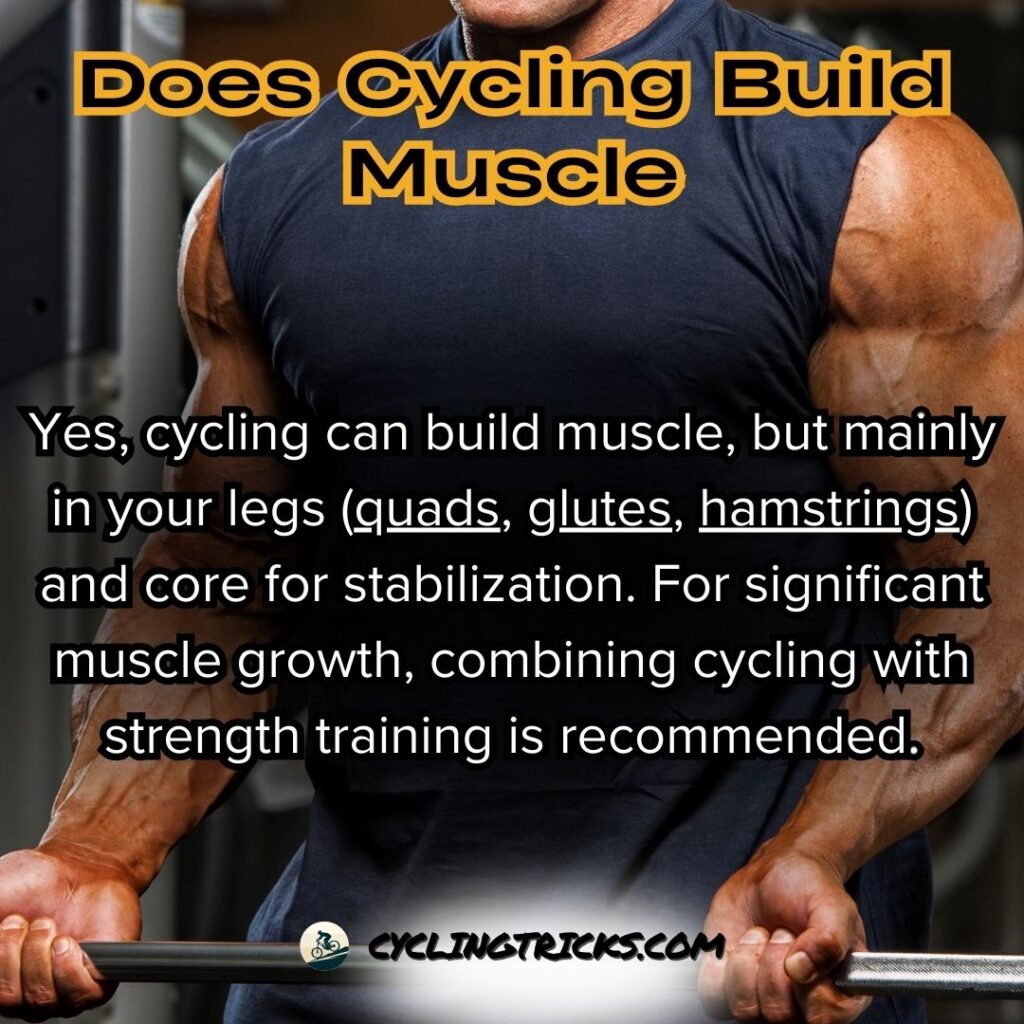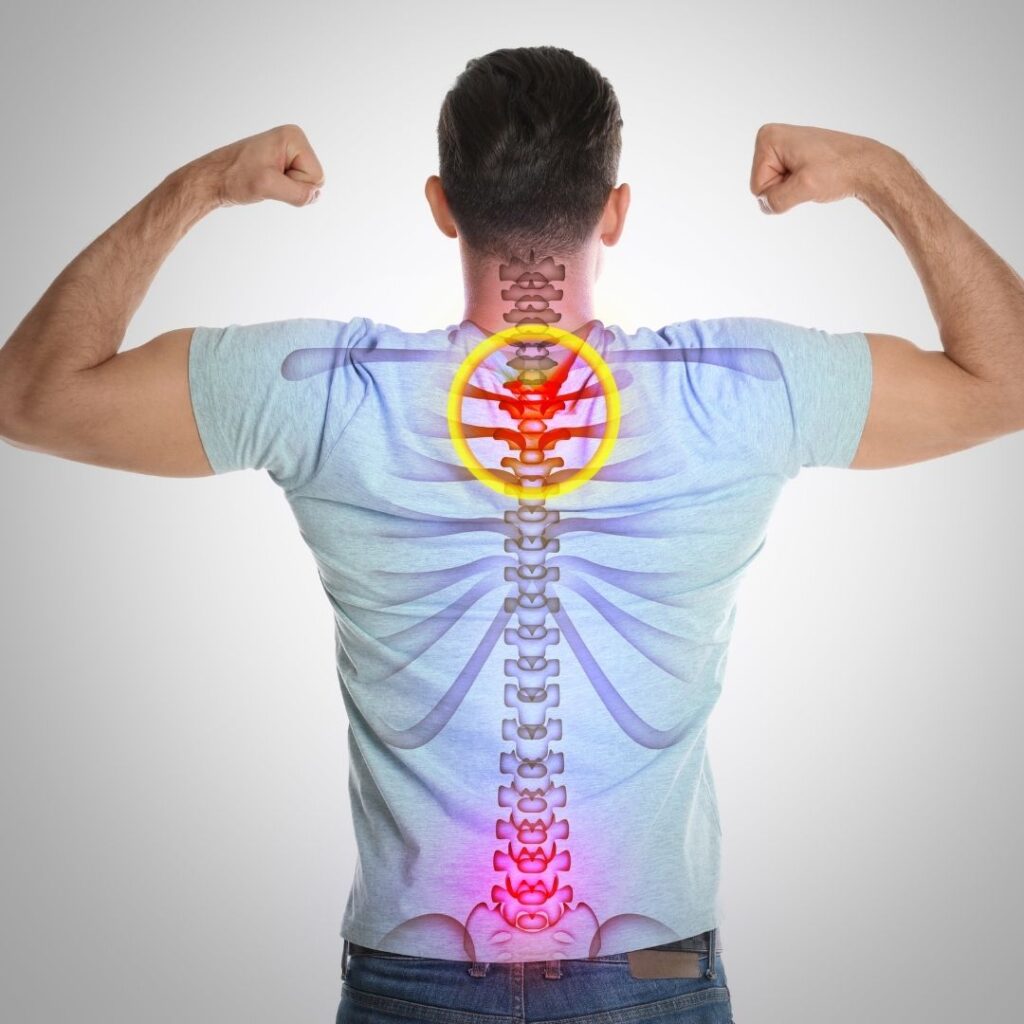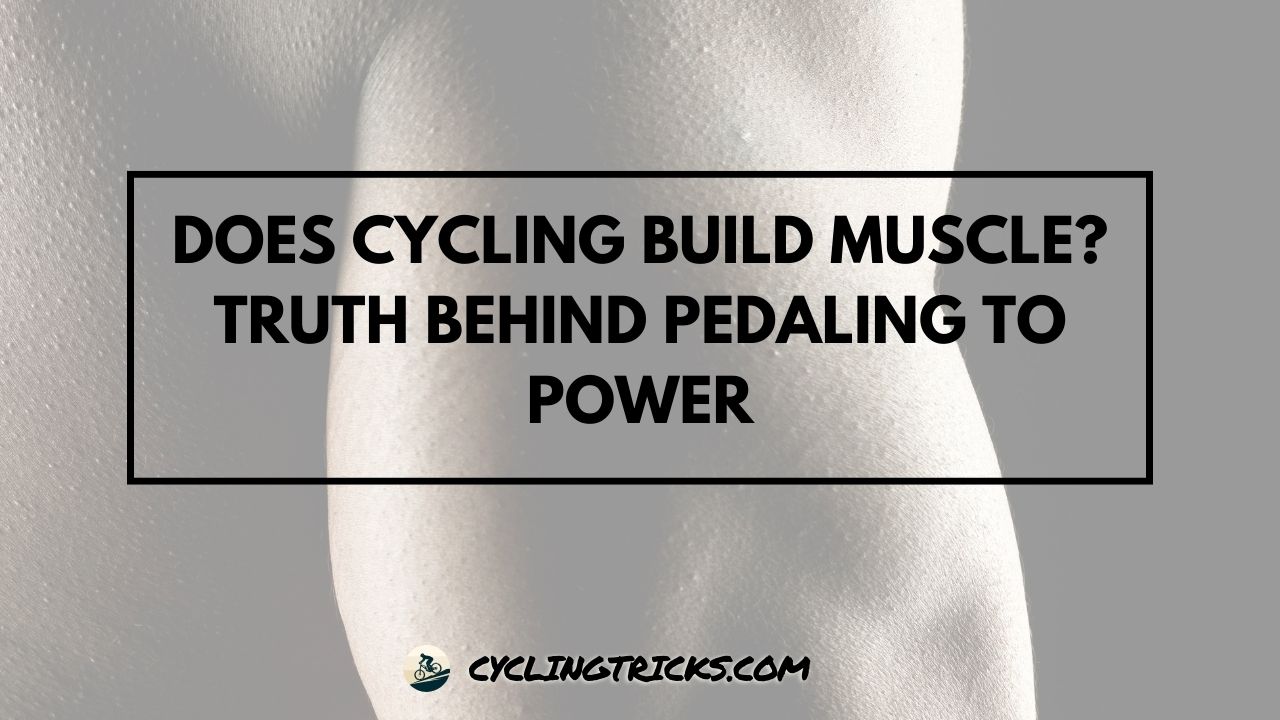Did you know that cycling is not just a cardio workout but also an effective way to build muscle? It’s true! Research has shown that regular cycling can have a significant impact on muscle building and toning.
So, if you’ve been wondering whether cycling can help you achieve those sculpted muscles you’ve always wanted, you’re in for a treat! In this article, we’ll explore the muscle-building potential of cycling and uncover the truth behind pedaling to power.
Key Takeaways:
- Cycling is not just a cardio workout; it can also help build and tone your muscles.
- Regular cycling engages multiple muscle groups, contributing to muscle growth.
- Cycling can enhance overall muscle strength and be included in your strength training routine.
- Leg muscles, including the quadriceps and calves, are particularly engaged during cycling.
- Through various mechanisms, cycling stimulates muscle growth and promotes muscle fiber development.
Does Cycling Build Muscle
Yes, cycling can build muscle, but mainly in your legs (quads, glutes, hamstrings) and core for stabilization. For significant muscle growth, combining cycling with strength training is recommended.

Benefits of Cycling for Muscle Building
When it comes to building muscles, cycling offers a wide range of benefits that can contribute to your muscle growth goals.
Whether you’re an avid cyclist or just starting out, incorporating cycling workouts into your fitness routine can help you achieve the toned physique you desire. Let’s take a closer look at the various advantages that cycling brings to muscle building.
Engaging Multiple Muscle Groups
One of the key benefits of cycling for muscle building is its ability to engage multiple muscle groups simultaneously. When you pedal, you activate muscles in your legs, including the quadriceps, hamstrings, calves, and glutes.
Additionally, cycling requires stabilization from your core muscles, further enhancing your overall muscle engagement. By cycling regularly, you can target and strengthen these muscle groups, leading to muscle growth and development.
Challenging Workouts
Cycling provides a challenging workout that can stimulate muscle growth. Whether you’re cycling on flat terrain or tackling hills and slopes, you can increase the resistance and intensity of your rides.
This resistance forces your muscles to work harder, leading to muscle fiber breakdown and subsequent growth. By regularly pushing your limits with cycling workouts, you can challenge your muscles and promote muscle growth.
Low Impact on Joints
Compared to other forms of exercise, cycling is generally low impact, making it an ideal choice for individuals with joint issues or those who want to minimize stress on their joints.
The low-impact nature of cycling allows you to perform high-intensity workouts without putting excessive strain on your joints. This enables you to focus on muscle building without worrying about joint pain or discomfort.
Cardiovascular Conditioning
While cycling primarily targets your leg muscles, it also provides a cardiovascular workout. By engaging in cycling workouts, you can improve your cardiovascular fitness, which indirectly supports your muscle-building efforts.
Enhanced cardiovascular conditioning enables your muscles to receive more oxygen and nutrients, promoting efficient muscle recovery and growth.
Variety of Training Options
One of the great benefits of cycling for muscle building is the wide variety of training options it offers. You can choose from road cycling, mountain biking, stationary biking, or even indoor cycling classes.
Each training option presents unique challenges and focuses on different muscle groups, allowing you to diversify your workouts and continually challenge your muscles for growth and development.
Benefits of Cycling for Muscle Building

| Benefits | Description |
|---|---|
| Engages multiple muscle groups | Cycling activates muscles in the legs and core, leading to overall muscle engagement and development. |
| Provides challenging workouts | The resistance in cycling workouts helps stimulate muscle growth by challenging the muscles. |
| Low impact on joints | The low-impact nature of cycling minimizes strain on the joints, making it suitable for individuals with joint issues. |
| Improves cardiovascular conditioning | Cycling enhances cardiovascular fitness, enabling efficient muscle recovery and growth. |
| Offers variety of training options | From road cycling to indoor classes, there are various training options that target different muscle groups. |
Impact of Cycling on Muscle Strength
When it comes to building muscle strength, cycling can have a significant impact. Incorporating cycling workouts into your fitness routine can provide a range of benefits that contribute to overall strength enhancement.
Whether you are a beginner or an experienced athlete, cycling can be an effective tool for improving muscle strength and endurance.
One of the key benefits of cycling for muscle strength is its low-impact nature. Unlike high-impact exercises like running, cycling puts less strain on your joints while still providing a challenging workout.
This means you can push your muscles to work hard without risking injury, making cycling an ideal choice for individuals of all fitness levels.

Cycling also engages multiple muscle groups simultaneously, which helps to improve overall strength and balance. While pedaling, you’ll recruit muscles in your legs, including the quadriceps, hamstrings, calves, and glutes.
Additionally, cycling requires core stability and upper body engagement for balance and control, further strengthening your abdominal muscles, back, and arms.
Furthermore, cycling can be an effective form of strength training on its own or as a complement to your existing strength training routine. When incorporated into a balanced fitness regimen, cycling workouts can help increase muscular endurance, improve cardiovascular fitness, and promote fat loss.
Incorporating cycling into your strength training routine can have a synergistic effect, helping you achieve your muscle-building goals more efficiently.
By alternating between cycling workouts and targeted strength training exercises, you can challenge your muscles in different ways, leading to increased strength, power, and muscle tone.
Cycling can be an effective form of strength training on its own or as a complement to your existing strength training routine.
Additionally, cycling workouts provide an opportunity for interval training, which involves alternating periods of high-intensity effort with active recovery. This type of training has been shown to effectively improve muscular strength and power while also enhancing cardiovascular fitness.
To maximize the muscle-strengthening benefits of cycling, it is important to vary your workouts. Incorporate different terrains, resistance levels, and cycling techniques such as standing climbs and sprints to continuously challenge your muscles and prevent plateauing.
In conclusion, cycling can have a significant impact on muscle strength, making it a valuable addition to any fitness routine. Whether you choose to cycle outdoors or indoors on a stationary bike, the benefits of cycling for muscle strength are undeniable.
By including cycling in your strength training regimen, you can enhance your overall strength, endurance, and muscle tone in a fun and low-impact way.
Building Leg Muscles Through Cycling
When it comes to building leg muscles, cycling is a fantastic exercise that targets and strengthens various muscles in your lower body. By hopping on a bike and pedaling away, you can work your quadriceps, hamstrings, glutes, and calf muscles, among others.
Quadriceps: Commonly referred to as the quads, these large muscles are located on the front of your thighs. They play a crucial role in propelling the pedals and generating power during cycling.
As you push down on the pedals, the quadriceps contract, helping you move forward with each revolution.
Hamstrings: Situated at the back of your thighs, the hamstrings act as the antagonist muscles to the quads. While the quads generate force during the downstroke, the hamstrings engage as you pull up on the pedals, completing the pedal stroke. By pedaling against resistance, you can effectively strengthen and tone your hamstrings.
Glutes: Your gluteal muscles, specifically the gluteus maximus and gluteus medius, are engaged during cycling to provide stability and power. As you push through each pedal stroke, your glutes contract, contributing to the forward motion and generating strength in your lower body.
Calf Muscles: The calves, comprised of the gastrocnemius and soleus muscles, are heavily involved in the pedaling action. As you push down on the pedals, your calves contract and remain active throughout the entire pedal stroke. This constant engagement helps strengthen and develop your calf muscles.
So, if you’re looking to sculpt and tone your leg muscles, cycling can be a highly effective exercise. By regularly incorporating cycling into your fitness routine, you can target and strengthen key leg muscles, resulting in improved strength, endurance, and definition.
| Leg Muscles Engaged in Cycling | Benefits |
|---|---|
| Quadriceps (quads) | – Increased power and strength – Improved pedaling efficiency – Enhanced muscular endurance |
| Hamstrings | – Balanced muscle development – Improved knee stability – Reduced risk of muscle imbalances |
| Glutes | – Greater power production – Improved hip stability – Enhanced overall lower body strength |
| Calf Muscles | – Strengthened lower leg muscles – Improved ankle stability – Enhanced pedal efficiency |
How Cycling Helps Build Muscle
In this section, we’ll explore the mechanisms behind building muscle through cycling and how it can contribute to your muscle-building goals. Cycling is an excellent form of cardiovascular exercise that not only helps burn calories but also stimulates muscle growth.
The Benefits of Cycling for Muscle Building
Cycling engages multiple muscle groups simultaneously, making it a highly effective full-body workout. When you pedal, your leg muscles, including the quadriceps, hamstrings, and calves, contract and relax, promoting strength and endurance.
Additionally, cycling requires core stability and engages the muscles in your abdomen and back. By maintaining proper posture while cycling, you can strengthen your core muscles, which play a key role in overall stability and power.
Furthermore, cycling can also help build upper body strength. While your leg muscles do the majority of the work, your arms, shoulders, and upper back come into play when steering, maintaining balance, and gripping the handlebars.
The Impact of Cycling on Muscle Fiber Type and Size
Cycling is primarily an endurance activity, which means it primarily targets slow-twitch muscle fibers. These fibers are responsible for long-duration activities and have a higher resistance to fatigue. Through regular cycling, you can increase the strength and endurance of these slow-twitch muscle fibers.
However, cycling can also have an impact on fast-twitch muscle fibers, which are responsible for short bursts of power and are typically associated with strength and explosive movements.
While cycling alone may not be sufficient to fully develop fast-twitch muscle fibers, it can contribute to overall muscle development and improve your athletic performance.
The Importance of Progressive Overload in Cycling for Muscle Building
To maximize muscle building through cycling, it’s essential to incorporate progressive overload into your training routine. Progressive overload involves gradually increasing the intensity, duration, or resistance of your workouts over time.
By gradually increasing these factors, you challenge your muscles and stimulate growth. For example, you can increase the resistance on your stationary bike, tackle more challenging terrains during outdoor rides, or incorporate interval training to add variability and intensity to your workouts.
Sample Cycling Workout for Muscle Building
Here’s a sample cycling workout that can help you build muscle:
- Warm up: Start with a 5-10 minute easy-paced ride to prepare your muscles for the workout.
- Main workout: Alternate between high-intensity intervals and recovery periods. For example, pedal at a high intensity for 1 minute, followed by 2 minutes of recovery pedaling at an easy pace. Repeat this cycle for 20-30 minutes.
- Cool down: Finish with a 5-10 minute easy-paced ride to gradually lower your heart rate and cool down your muscles.
| Benefits of Cycling for Muscle Building | Impact on Muscle Fiber Type and Size | Importance of Progressive Overload |
|---|---|---|
| Engages multiple muscle groups Strengthens leg muscles Enhances core stability Builds upper body strength | Targets slow-twitch muscle fibers Increases endurance Contributes to overall muscle development | Challenges muscles for growth Incorporates progressive overload Improves athletic performance |
Cycling for Muscle Tone
When it comes to achieving muscle tone and definition, cycling can be an excellent workout choice. Regular cycling workouts can contribute to sculpting and toning your muscles, helping you achieve a lean and defined physique.
One of the reasons why cycling is effective for muscle tone is that it engages multiple muscle groups throughout your entire body. While pedaling, your leg muscles, including the quadriceps, hamstrings, and calves, are continuously working to propel you forward.
Additionally, your core muscles, such as the abdominals and lower back, come into play to stabilize your body and maintain proper posture. Even your upper body gets involved as you grip the handlebars and use your arms and shoulders to steer and balance.
As you cycle regularly, your muscles adapt to the demands of the exercise, leading to increased strength and tone. The resistance provided by pedaling against the gears and the weighted flywheel of stationary bikes can further enhance muscle development.
By varying the intensity and duration of your rides, you can target different muscle groups and challenge them in various ways, promoting further muscle growth and definition.
Moreover, cycling is a low-impact exercise that puts less stress on your joints compared to high-impact activities like running. This makes it an ideal choice for individuals with joint issues or those who want to avoid excessive strain on their bodies while still enjoying an effective muscle-toning workout.
Benefits of Cycling for Muscle Tone:
- Engages multiple muscle groups, including the legs, core, and upper body.
- Increases muscle strength and tone through regular adaptation and resistance.
- Offers a low-impact workout that is gentle on the joints.
- Provides an enjoyable and versatile exercise option for individuals of all fitness levels.
Regular cycling workouts can be a fun and effective way to build muscle tone and definition. By incorporating cycling into your fitness routine, you can enjoy the physical benefits while exploring new places and experiencing the joy of pedaling to power.
| Muscle Group | Benefits of Cycling |
|---|---|
| Leg muscles (quadriceps, hamstrings, calves) | Targeted muscle development and increased strength |
| Core muscles (abdominals, lower back) | Improved stability, posture, and core strength |
| Upper body muscles (arms, shoulders) | Engagement and toning of upper body muscles during rides |
Conclusion
In conclusion, we have explored the muscle-building potential of cycling. Throughout this article, we have discussed the benefits that cycling offers for muscle growth and how it can contribute to enhancing overall muscle strength.
By incorporating cycling into your fitness routine, you can leverage its effectiveness in building and toning your muscles.
Cycling engages multiple muscle groups, providing a challenging workout that stimulates muscle growth. It particularly targets the leg muscles, including the quadriceps and calves, helping to build strength and tone in the lower body.
Moreover, cycling workouts can help promote muscle definition and sculpt a lean physique.
Not only does cycling offer physical benefits, but it also brings joy and fulfillment. The simple act of pedaling to power allows you to immerse yourself in the beauty of nature or explore new surroundings. Embrace the freedom and exhilaration that cycling brings, while reaping the rewards of improved muscle tone and strength.








